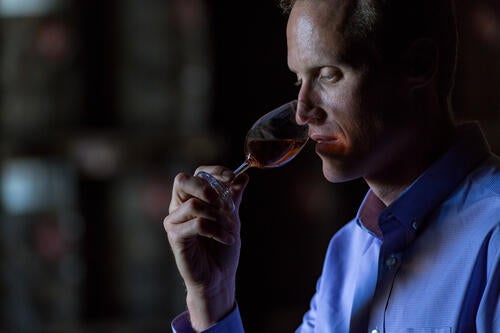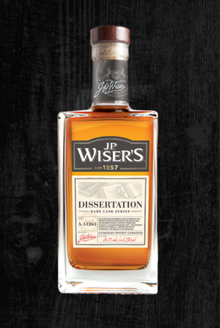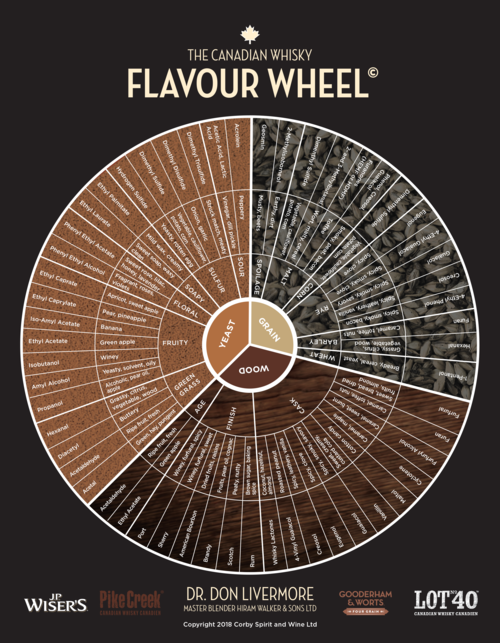Explore the spirit of Canada with the Whisky DocCanadian whisky is as diverse as Canada itself.
Let award-winning master blender Don Livermore (BSc ’95) help you find your new favourite.
Like an amber river, whisky* runs through the landscape of Canadian history. Some might argue that without the economic fuel whisky provided, this country might not exist. It’s been produced here for more than 250 years; at one point, whisky was our leading manufactured export. And as Canada’s earliest and largest taxpayers, the whisky barons bankrolled much of the country’s early infrastructure.
Don Livermore (BSc ’95) is proud to be part of Canadian whisky’s story. He’s the master blender at Windsor-based Hiram Walker & Sons Ltd., North America’s largest beverage distillery. Don is responsible for some of Canada’s best-loved whisky brands, including Lot 40, Pike Creek and JP Wiser’s. And he’s also one of only a few master blenders in the world to earn a PhD in brewing and distilling — hence his nickname, the Whisky Doc.
Don not only creates award-winning whiskies, he has also helped to shape the industry itself. Here, he shares some of the milestones in his 25-year career with Hiram Walker, along with tips to help you explore Canadian whisky’s vast range of styles and flavours.
From microbiologist to master blender
Don’s interest in science was sparked by his high school biology teacher, who also happened to be a Waterloo alumnus. Embarking on his own studies at Waterloo, Don wasn’t sure which area of biology he wanted to specialize in until he took some microbiology and biotechnology courses.
“I loved those courses. In my third and fourth year, I took as many of them as I could. I also had to take a physics course, which I really wasn’t interested in. My thought leaving university was to work on the pharmaceutical side, fermenting things or rearranging DNA, that sort of thing,” he says.

In 1996, Don joined Hiram Walker as a microbiologist. Early in his career, he developed a technique using near-infrared reflectance spectrometry (NIRS), which measures how light scatters off and through a sample. It cut the time needed to analyze alcohol, sugar and acid content from hours to seconds and changed how the entire distilling industry monitored its fermentation processes. (It seems that physics course paid off.)
Don went on to contribute a chapter on his work to the alcohol industry’s definitive textbook and has lectured around the world on the subject.
While upending the whisky business, he also earned his masters and PhD, studying via distance education at Heriot-Watt University in Scotland, a world-famous centre of excellence in brewing and distilling.
The week that I defended my PhD was the same week I got promoted to master blender here at Hiram Walker. It was one of the best weeks of my life.

To mark the successful completion of his doctorate, Hiram Walker produced 78 barrels of the blend Don created as part of his thesis. Aptly named JP Wiser’s Dissertation, it won Best Canadian Blended Whisky at the 2018 World Whiskies Awards.
“I have a few bottles of that one — it’s my thesis in a bottle,” Don says with a laugh.
Today, Don is a passionate ambassador for Canadian whisky and a champion of the people who help to produce it.
“We’re shy as Canadians, but we need to shout out about the quality of products that we make. We’ve got award-winning whiskies here.”
He should know. For the past five years, his creations have been named World’s Best Canadian Blended Whisky at the World Whiskies Awards.
“And it all started with me being inspired by fermentation while I was at Waterloo. The skills I learned there are the ones I still use every day,” he says.
Ready to explore Canadian whisky?
According to Don, Canadian whisky is the most innovative and adaptable style of whisky there is. That’s because, while other whisky categories like bourbon or Scotch have strict regulations governing how they must be produced, there are far fewer rules for what constitutes a Canadian whisky.
This leeway means master blenders can be far more creative when making Canadian whisky, experimenting with different grains, barrels, fermentation and distillation methods to create unique flavours and a whisky for every palate.
To help consumers understand how all these variables influence a whisky’s flavours, Don developed the Canadian Whisky Flavour Wheel, now copyrighted in 170 countries, for the Liquor Control Board of Ontario.

The wheel focuses on the three components that influence flavour — yeast, wood (the barrels in which whisky is aged) and grain. It allows you to look at whisky from the mindset of a master blender.
Once you’ve seen where the flavours come from and decided on the tastes you’re looking for, Don recommends asking staff at your liquor store for whiskies that fit the bill.
Other sources of information (once pandemic restrictions ease) could include a visit to a whisky festival, like Spirit of Toronto, Victoria Whisky Festival or Chicago’s WhiskyFest.
You can even attend a whisky blending class with Don, where you’ll learn how whisky is made and create your own custom blend.
And if you’re interested in learning more about the life of a master blender, you can follow Don on Twitter, LinkedIn and Instagram (@CDNWhiskyDoc).

Have
a
drink
with
Dr
Don
“I
like
cocktails
where
the
whisky
shines
through,”
Don
says,
and
a
Manhattan
is
one
of
his
favourites.
He
recommends
using
a
rye-forward
whisky
like
Lot
40.
Just
mix
two
parts
whisky
with
one
part
vermouth
and
a
dash
of
bitters.
Enjoy!
*Generally, Canadian and Scotch whisky makers refer to their product as ‘whisky’, while American and Irish producers use ‘whiskey’.